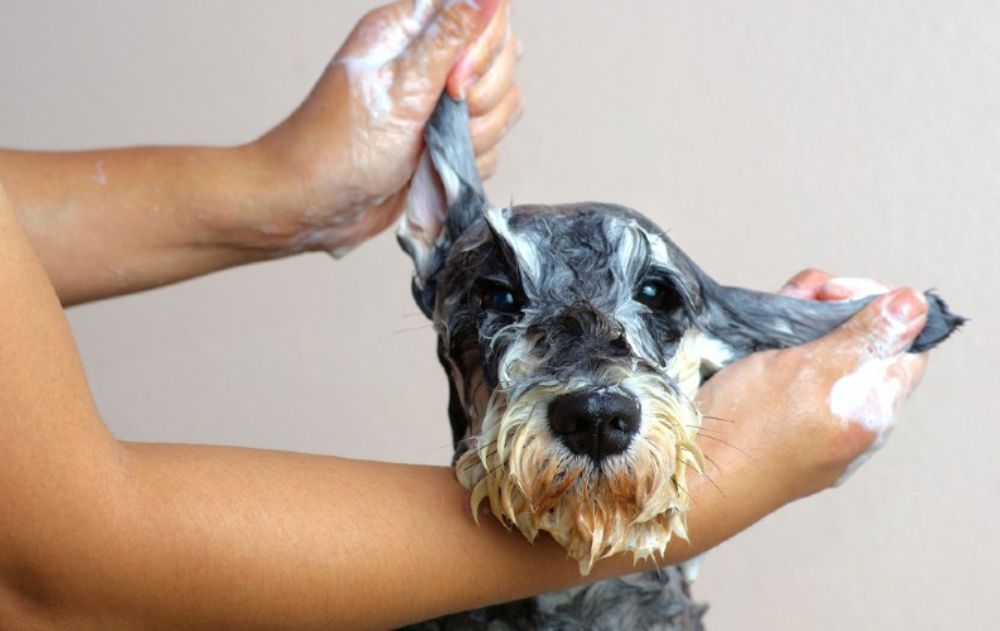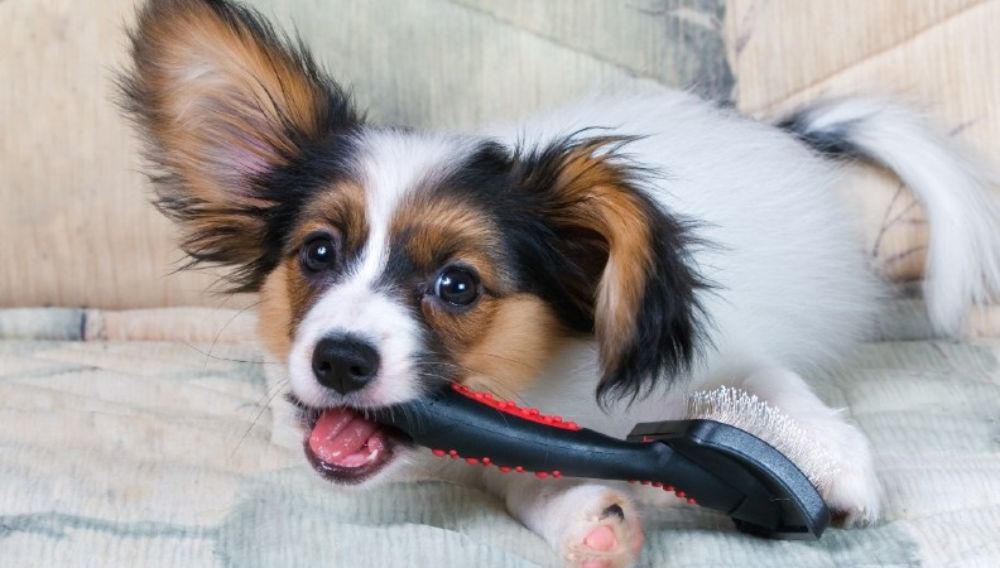
Want to know to keep the dreaded damp dog smell at bay, top tips for bath time or the best type of brushes to buy? From top to tail (and everything in between), here’s the what every owner needs to know when it comes to dog grooming…
Why Groom Your Dog?
It might not seem that way when your Golden Retriever emerges from a muddy puddle, but dogs do have at least some inbuilt ability to keep themselves clean. It’s thanks to the natural oils in their skin. So a big part of grooming is about giving nature a helping hand; brushing to help remove dead hair and to bring out those natural oils and helping to spread them around the skin. It all helps to maintain that glossy sheen.
Through regular grooming, you are also removing any build-up of dirt, excessive hair and dandruff (something that’s good for your dog as well as your furniture and carpets!). At the same time, this is your opportunity to check that everything’s ok with your buddy, by inspecting their coat, skin, eyes, ears, paws and teeth and checking for signs of skin irritation, infection and parasites. Start when your pooch is young, and they’ll soon realise that having a groom is an experience to look forward to.
And did you know when you check your dog, hands-on contact can help reduce stress and lower blood pressure? As well as being an opportunity for bonding, grooming a dog can actually be good for us humans, too.
Essential Dog Grooming Kit…
Depending on the breed of dog and length of the coat, there are some items which are essential. But which ones? Well don't worry, we know there's all types of brushes on the market. So to save you a lot of time, make sure you've got these in your grooming kit…
Bristle brush: This is a good all-round brush for a range of coat types. Opt for wide-spaced bristles for brushing longer coats and narrow-spaced bristles for short-haired breeds. For coarse hair (Border Terriers, for instance), go for short stiff bristles.
Pinhead brushes: Because the pins tend to be longer than the bristles on bristle brushes, these are good for dogs with a top layer of long to medium hair. Use this to tidy up that top layer, but also use a bristle brush to remove loose hairs.
Slicker brushes: Great for picking up loose hair and dirt on short to medium-haired dogs and curly breeds.
Wide-tooth comb: Used for removing mats and tangles. These are available in a range of teeth lengths for short, medium or long-coated dogs.
Undercoat rake: For the likes of Retrievers and Spitz breeds where there is a short, thick undercoat and a longer top layer. These are good at getting through the top layer and getting down to the undercoat, breaking up tangles and clearing away loose fur.
Grooming glove or mitt: A “hands-on” way of removing dirt and dead hair from a shorter coat. It’s like a glove, so your pooch will just think you’re giving him a good stroke and cuddle! Great if you’ve got a nervous dog that’s not too sure about grooming time.
Cotton buds: Used for carefully clearing away dirt and debris from around the eyes, ear canal and face.

Grooming Your Dog Based on Their Coat Type
Different dogs have different coat types, and not every groom needs to be done by a professional dog groomer. With the right tools and a good understanding of your dog's coat, you can give it a go and save yourself some money.
Short, smooth coats. Using a bristle brush or grooming mitt, brush gently from front to back, making sure that you brush all the way down to the skin.
Medium-length, dense, curly or double coats. Inspect the entire coat for tangles or matting and remove these with a matting comb. To avoid pulling at the skin, take hold of the area of hair with one hand and comb out the matt with the other.
Long haired, silky coats. Carefully go over the coat with a pinhead brush, checking for any tangles along the way. For very clumpy matting or tangles, you can use baby oil or liquid detangler to free them up. Finally, go over the entire coat with a wide-spaced bristle brush.
How Often Should I Groom My Dog?
Again, this is breed specific. But as a general guide, short, smooth coats should be brushed at least once a week, medium coats every other day and longer coats on a daily basis.
It's a good idea to start your dog’s grooming experience from as young an age as possible. With puppies, take a “little and often” approach to grooming. By giving them a quick and gentle once-over with a brush (even when they don’t need it), they gradually get used to the whole process.
Also, give plenty of praise while grooming and reward them at the end with a treat or their favourite toy. This way, it becomes associated with fun - rather than a stressful ordeal.
Clipping and Stripping: Reasons to Call the Professionals…
Even many short-haired breeds benefit from hair clipping every few months to help keep their coat manageable. For the likes of the Afghan Hound and Labradoodle, clipping is recommended every four to six weeks.
Yes, you can do it yourself with a pair of clippers. Not just any old clippers though, clippers for grooming dogs need to be quite heavy duty, a regular beard trimmer won't always be able to do the job properly.
But when it comes to it, even the most easy going of dogs isn’t going to stay completely still. And especially for a novice, it’s so easy to snip off way more than you intended - or even nick your buddy’s skin. Tackling awkward areas such as the tail and the bottom of the legs can be an especially tough job.
Once or twice a year, most terriers, spaniels and several other breeds benefit from stripping, this is where the old coat is systematically removed, leaving room for the new one to grow evenly. In the right hands, stripping should be a simple, pain-free process (pros use a stripping stone or stripping knife).
A typical grooming session costs around £30.
Bathing Your Dog
Rule number one on bathing: don’t overdo it! Too much bathing can interfere with the production of natural oils, dry out the skin and reduce the strength of the coat. Unless your vet advises on more frequent bathing, dogs only generally need a bath if the coat is visibly dirty or if it smells (some dogs have the lovely habit of rolling in poo)!
Other reasons you might need to bath your dog are if they have dandruff caused by dry, irritated, or oily skin, have itchy skin because of a particular skin disease, or if they have fleas, mites or lice and a medicated shampoo is needed.
Here are some more tips for easy bathing…
- Get a shower-mixer tap. It makes the job of rinsing the coat so much more efficient!
- Only use dog shampoo. The pH balance of canine skin differs from that of humans. Dog shampoo is formulated to reflect this.
- Brush your dog beforehand. Matts should be removed as they hold water and cause irritation so make sure you remove them before bath time.
- Temperature: warm, not hot! Warm water only - a similar temperature as for a human baby.
- Check the shampoo instructions. With some types, you need to dilute before use. Be sure to rinse well, as any soap left in the hair can lead to irritation.
- Towels are usually best. Hot air from blow dryers can cause dryness of the skin. And some dogs just don’t enjoy the experience, so towel drying is the way to go.
Everypaw Dog Insurance
Everypaw's Dog Insurance comes with 24/7 unlimited access to vets and vet nurses that can help with your pet's health, care, nutrition and behaviour. So you can rest assured your pup will be well looked after.
Content reviewed by Vetstream Canis - https://www.vetlexicon.com/treat/canis
Vetstream’s Vetlexicon is the world’s largest peer-reviewed online clinical reference source. All our content is written and peer-reviewed by over 1,000 of the world’s leading veterinarians, ensuring relevance, accuracy and quality.